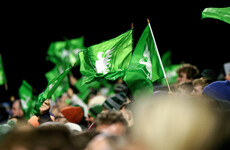THE YEAR IS 1976 and a group of hardy Irishmen, battered and bruised, are happy to be getting out of New Zealand alive as they board an airplane destined for Fiji.
It’s been a year of firsts for the Ireland rugby team. They’ve just become the first Irish squad to tour New Zealand. They are about to also become the first Irish team to visit Fiji. To this day, they remain the last.
The contrast between the two legs of that tour could hardly be greater.
It didn’t take long for the group to discover that New Zealand is a tough place to go, particularly when the country is experiencing one of its coldest winters on record.
Out-half Mick Quinn was 24 years of age and on his first international tour when sprung off the bench against Canterbury. He jogged past famed New Zealand backrower Alex ‘Grizz’ Wyllie as he found his place on the field. “You’ve come a long way to die, son,” Wyllie snarled. Quinn fired back a less than complimentary remark about Wyllie’s facial features and spent the next 20 minutes trying to avoid the enraged All Black.
“The New Zealand tour, we went quite well,” Quinn remembers. “We lost to Auckland early on, I played on the wing. We had a few injuries. Lost 13-10, very close, should have won.
“We lost in Canterbury (18-3). We had heard about how tough they were, with the Lions in ’71 there was a huge bust-up there. Half the Lions team ended up not playing again on the tour because they got bashed up so badly. Their front rows were really tough, so we were sort of ready for that.”
- For more great storytelling and analysis from our award-winning journalists, join the club at The42 Membership today. Click here to find out more >
Ireland were tough enough themselves, but didn’t quite inspire the same levels of fear in their opponents. Moments before that Ireland team became the first to face an All Black haka in New Zealand, they had stood for a stopgap Irish anthem. This being in the days before Ireland’s Call, the New Zealand Rugby Union had been told to just play an Irish tune in place of Amhrán na bhFiann.
“You know what tune they played?” Quinn says, “The Rose of Tralee. So we’re standing there singing the fucking Rose of Tralee, ‘The pale moon was rising, up above the green mountain…’ I was standing beside Mike Gibson and I said ‘Gibbo, tell me this is going to scare these fecking Maoris?’ I can assure you it didn’t.”
Ireland played well but lost the Test 11-3 – Barry McGann kicking their only points – leaving the tourists with a record of four wins from seven games. The final leg of the tour provided another step into the unknown, as Ireland headed to play Fiji in Suva.
“Getting to Fiji was a bit of a celebration after having got through the tough end of the tour,” remembers John Cantrell, who played at hooker on that Ireland team.
“The few days in Fiji were a bit more relaxing. Sub-tropical, with your palm trees and all that sort of stuff.”
“It was beautiful,” says Quinn. “But you could see the poverty in the place. We were driving around sight-seeing, going on dirt roads, people living in mud huts.
“Then we met up with a lot of the Fijian players, and they were very nice fellas. Very gentle people. We had a lovely time.”
It was an in-and-out job. Ireland arrived in Fiji on Monday, 7 June, and were on a plane back to Dublin four days later. With the game played on the Wednesday, it allowed the group a small window to unwind.
While the squad’s exemplary behaviour had been noted in New Zealand, in Fiji an element of mischief creeped in. One member of the Ireland touring party was so entertained by the fact the buses had no glass in their windows that he decided to present his bare backside while passing through a small Fijian village. Karma ensued with the subsequent loss of his traveller’s cheques to the stiff coastal breeze.
For others the Fiji leg presented a welcome opportunity to test themselves against international opposition. Scrum-half Robbie McGrath was called up to join the tour after Donal Canniffe injured his ankle in training.
“I had just moved to Drogheda, and I had only started a job up here. Next minute I get a call to go to New Zealand, so that was an interesting start,” McGrath laughs.
He played the full game against Fiji but would need to wait another seven months to earn his first international cap. At the time, Fiji were not officially recognised as a Test team.
McGrath was happy to just be part of the action. There are few similarities between June in Suva and Drogheda.
“Fiji was lovely. Beautiful country, beautiful place. I remember the hotel had a lovely swimming pool in it. A few of the lads, Willie Duggan, Moss Keane and one or two others, they couldn’t swim, so they would go sit in the kiddies pool on chairs because they were afraid of the water.”
“On the day of the match in Fiji, Moss Keane wasn’t playing,” Quinn adds. “So himself, Barry McGann and three or four other lads are in the swimming pool as we’re getting ready to head off to the ground. They were going to follow on later.
We changed in the hotel because there were no real dressing rooms in the stadium. After, we’re sitting waiting on the bus and one of the lads says ‘Oh look at Moss, he’s waving to us.’ Then we realised he was actually drowning. He couldn’t swim. We all thought he was waving, then next thing we’re all going ‘Jesus, he’s dying!’ The lads had to dive in and save him and pull him to the surface. That was our send-off to the match.”
It soon became clear that the fixture would not be what the IRFU would have hoped. The attendance was noted as 12,000, but Fijian newspapers put the figure closer to 17,000 as locals packed into the tight surroundings and scrambled for impromptu vantage points.
This was despite the fact the Fiji team were essentially double-booked, with half of their squad in Australia preparing for a Test match against the Wallabies three days later. In order to fulfil the Ireland fixture Fiji plumped up their squad with a couple of the more talented players from the islands, meaning a small group of first-team players took to the field alongside some very raw stand-ins.
“It was totally unique, because they were totally disorganised,” Cantrell says. “They didn’t have any set manner or set play, and I think because they would have been put together (for that game) and some of them came in from the outlying islands, they probably didn’t know each other that well either and wouldn’t have practiced that much together. So they played this natural, flowing game where everything went between long passes, short passes, high tackles, that was the format.”
The setting also left much to be desired, with the idyllic backdrop of blue seas and palm trees in stark contrast to the soggy turf underfoot.
“The pitch was dire,” Quinn says. “It had been raining the previous day and the mud was very deep, so the game never really got going. Obviously we thought that playing Fiji, it would be a really open game, and it was, but the teams could barely function because it was so muddy.”
Ireland, of course, were used to a bit of mud and rain. Other factors proved far more alien.
“We ended up scrummaging beside what turned out to be some sort of nest of frogs,” Cantrell says. “As we were going down to scrummage they started jumping up and they were the size of your fist. The referee just said ‘OK, we’ll move another 10 yards and have the scrum over here.’”
“They were big bastard frogs too, they weren’t like the little frogs you might see here,” Quinn adds.
“You were literally running through and frogs were jumping out of your way. It was incredible. These were big guys, and you’d be afraid of hitting one of them. We didn’t want to do any damage to them!”
Unsurprisingly, it turned into one of the most chaotic fixtures an Irish team has ever played in.
Already struggling to negotiate a smaller pitch than usual, and with a healthy crowd spilling over the sidelines, Ireland’s players were further disoriented as the mud smudged the pitch markings beyond recognition.
“The try-line was very short to the deadball-line, very short, as the pitch was quite small and the crowd were in on top of us,” McGrath says. “At one point Tony Ensor ran over the try-line, but then managed to go over the deadball-line as well!”
Ireland eventually took control just after the half-hour mark when Tom Grace showed a good turn of pace to get over in the corner. Quinn, struggling to place his feet in the saturated grass, saw his conversion attempt drag wide as the South Pacific Ocean glistened in the background.
Quinn had a love for Fijian rugby having beaten them with Leinster three years previously. He remembers their backs playing the game in a manner that inspired the young out-half.
The rugby in the game was fantastic. They were athletic, they were fast, they were big, big men. Muscular, very physically strong guys. But they played with such flair. You’d almost describe them like the Harlem Globetrotters, they played with that sort of style and panache. They ran the ball, played these one-handed passes, passing out of the tackle and all that sort of stuff. We learned a lot by playing against them.
“One thing I learned from the Fijians was the ability to pass out of a tackle,” he explains.
“As an out-half, you can get half-gaps that aren’t complete gaps, and I used to throw myself into the gap and give one-handed passes to my centres behind their centre, and you could put them away in the clear.
“The Fijians were the best in the world at that. They were just fantastic. There was a lot to learn from them, they were class players were so much natural ability. It was incredible, and wonderful to watch.
“We always thought Isimeli Batibasaga was a world-class player, the scrum-half. He was a brilliant player. The other guys, you wouldn’t really know the names of all of them but they were such talented players. They had such an athleticism that we didn’t have.”
“We sort of knew that they were going to throw the ball around the place,” McGrath says. “We knew that, but we threw the ball around ourselves quite a bit too. They just weren’t great with the basics, because they wanted to run everything and they would knock on a few balls and things like that.”
In the front row Cantrell was exposed to a less flamboyant side of their game.
“They’d take your head off if they could, but that was not seen as too dangerous at that stage. By today’s standards there might not have been any Fijians left on the pitch.
“Having said that, we had just come from New Zealand and in those days, if you were on the ball in a ruck or you were on the wrong side of a ruck, you got shoed out of it with studs. You generally weren’t kicked in the head, but it did happen. The vast majority of the games (on that tour) were very tough, and you made sure you weren’t on the wrong side of a ruck.
“(But) they would throw the ball around. At one stage one of them tried to throw this pass 50 yards across the pitch. Today you’d just kick it, but they were throwing these huge long passes way over everybody. They’ve always had that element to their game.”
“It was a tough game,” says Quinn. “It was physically tough simply because it was so slow, again because of the mud, and then you were getting hefty belts. They were tough enough lads. I remember getting a dead leg and I had to hobble through the second half of the game. You couldn’t bring on subs in those days unless you were nearly clinically dead.”
Given the makeshift nature of the Fiji team, things fell apart when it came to Cantrell’s bread-and-butter, the set-piece.
“At that stage, the hooker had only started throwing the ball in as well,” he says, “so there was a lot of confusion in lineouts and about where to put the ball.”
With the rules only liberally applied the game quickly unravelled. In the second-half Ireland coach Roly Meates had to intervene after Fiji introduced a third substitute, one more than the permitted two. After a bit of convincing, Meates won the argument with the Fijian match official.
Five of the Irish pack required medical attention over the course of the scrap, and a high tackle forced Cantrell off with a neck injury.
Ireland crossed for their second try 10 minutes from the end, Ulster’s Roger Clegg providing the final touch after some good work by Harry Steele. Stewart McKinney failed to add the extras, leaving the tourists with a two-try, 8-0 win.
Fiji held their own, with Batibasaga’s performance the talk of the local papers despite missing three long-range penalties. The president of the FRU said he’d hope to see Ireland return soon and often, with the net takings reported at a tidy $10,000.
This of course was of little interest to the handful of rugby writers on hand to witness the contest. In the Evening Herald, Sean Diffley described the game as “the most bizarre rugby match I have ever seen.”
Almost 45 years on, the players involved simply remember it as a colourful ending to a wonderful tour.
“We were very close and we played well on that tour,” Quinn says. “Fiji was a nice end to it, and we certainly enjoyed ourselves. It was a wind down from the New Zealand tour, which wasn’t stressful, but it was tough.”
“In those days, Leinster, Munster, Ulster and Connacht, they were all big rivalries,” Cantrell continues.
“So when you get together as a team it does bond players together. That’s the most important thing with any of those trips. That didn’t really exist that much beforehand, so the touring element certainly benefitted that in a huge way. You talked more, you met more of your fellow players from the provinces and you understood more.
“It was a great tour, and a great learning curve.”
For more great storytelling and analysis from our award-winning journalists, join the club at The42 Membership today. Click here to find out more >



















You’ve fired a guy for having an opinion. How’s that exactly inclusive?
@Nathan Mawhinney: He should have just said ‘sodomites’ instead and saved everyone the trouble.
toxic rating: 4.4/10
@Nathan Mawhinney: Nathan, you’ve commented on every single Israel Folau article the past week. Same rhetoric today and it’ll be the same tomorrow. We know how you feel. Move on.
@Mike: you are incorrect sir, commented on many but not all. Thankfully there isn’t a restriction.
@Nathan Mawhinney: nah they’ve fired him for posting his discriminatory opinions all over social media after multiple warnings. Genuine question Nathan, if an athlete came out and tweeted that black people are going to hell, would you be defending him then?
@Laura Walsh: to make it more applicable to myself and he was to say white men were going to hell I’d think he was crazy. Why get triggered especially if you don’t believe in hell? He’s never screamed these words at anyone, he posted them on social media.
@Nathan Mawhinney: he was sacked for a breach of conduct but you know that already. You just like playing this up as a freedom of speech/ snow flake issue, which you know it isn’t, to get your reaction.
He’s not been arrested. His tweet/ post are still up. His freedom to speak his mind has not been impeded.
He’s been sacked because his comments do not reflect the views of his employers and he had specifically agreed to follow their line in order to receive a new contract.
Then again you know all of that.
@Nathan Mawhinney: why is religion an acceptable excuse to publicly make a negative statement about an entire group of people based on their sexual orientation? This waffle some people are spouting about him trying to save people is missing the point, he is tarring homosexuality as a negative thing no matter what way you look at it. This helps forms the foundation of negativity towards gay people that we are working so hard to get rid of. We as a society decide what is acceptable as we have done/continue to do for sexism, racism etc. This is no different, hiding behind religion is only an excuse to stick your head in the sand and avoid addressing the real issue here. Discuss the point on its merits, not what book it was written in a long time ago.
@Nathan Mawhinney: Not exactly, almost a year ago to the day, he posted something very similar to the post he was recently fired for, on that occasion he was warned. He subsequently went on to sign a new contract just 2 months ago, you can be damn sure there were stipulations attached to the most recent deal in light of his previous comments. He was under no obligation whatsoever to sign that deal if he wasn’t comfortable doing so. He could have easily retired there and then and gone on to preach whatever he wants. Stop making him out to be some kind of victim here, he was well aware of what would happen, and did it anyway, his views are completely at odds with ARU policies and those of ARU sponsors too, they had no option but to fire him.
@George Can’t-Stand-Ya: I never labeled anyone a snowflake, completely understand where people are coming from especially if he signed a contract about this stuff. Just think the world now attacks people for the words they say, even if they aren’t harming anyone.
@Nathan Mawhinney: Any clown/troll can post racist comments online. But if you represent in sports a country where homosexuality is legally accepted, then you have a massive responsibility and duty to conduct yourself in a way that will never cause any pain or possibly even suicidal thoughts in members of the public. If he wants to make endless childish hateful neanderthal remarks then there are countries he can move that not too many people desire to live in where this type of carry-on is accepted.
@Nathan Mawhinney: give it up. Now you’re just willfully ignorant and that’s far worse than just being dumb.
@Nathan Mawhinney: how could the sport be inclusive if we allowed players to discriminate against people based on sexual orientation? By your logic it was wrong to ban South Africa during the apartheid era
@Sean Mannion: so he shouldn’t take up employment if his religious beliefs don’t correspond with those of the company he is looking to join? Hiw does that work for Muslim people working for western companies?
@Rudiger McMonihan: Folau is not and has not discriminated against anyone, he’s on record as saying he is not homophobic and went as far as to be on the cover of a magazine promoting a gay rugby tournament. What he did was re-state what is written in the scriptures of his religion in an effort to save the so called sinners. He has gay family members who he equally wants to save.
@Dino Baggio: he publicly admitted thst he and his god see gay people as lesser. He/his faith picks and chooses what they want to believe from the Bible even though they believe it’s without error.
@Dave O Keeffe: where did he say he and his god see gay people as “lesser” ? He said all sinners must repent or burn in hell which is pretty much how all religions see sinners. Unless these views are made illegal he should be allowed air then in public without fear of persecution.
I think politics and religion should be kept out fo sport… but if Israel falou can’t express his religious beliefs equally we shouldn’t be subjected to lectures on equality, diversity and political correctness.. including from the42!
@Padjo Mulk: agreed
@Padj
Lets jut get to the sacking of this employee of the Austrian RFU ::
Last year he signed a contract saying he will not do the same thing again but recently he broke that contract and he was fired .
SIMPLE
@Padjo Mulk: You’re completely missing the point Padjo. You have to abide by the laws of the country you live in even if your beliefs don’t agree with them. I suggest that if he wants to live in a country where people hate gays then he should move to Bangladesh or Pakistan.
@Padjo Mulk: but he can. Just as equally as his employers can show how they feel by not paying him anymore.
@Frantic Pigeon: I hope people who are similarly intolerant to people’s religious beliefs are subject to the same punishment…but I doubt it.
@Padjo Mulk: @Brysonpieters: He’s entitled to his chosen beliefs, that’s all they are, but he’s not entitled to dish out out hateful bullshit against minorities of people who have no control of an aspect of their being, such as their sexual orientation or skin colour. That kinda shite legitimises discrimination
We are constantly being told that Rugby is “inclusive”. Well it wasn’t when I was regularly mocked for being a Christian and was never selected again for my club U20s team after I spoke to the coach about him using the name of Jesus as a swear word. It isn’t inclusive when Stuart Barnes is happy to put these “inclusive” words in print: “Always loathed the way those Islanders formed a circle post-match their praises to what I regard as a fabrication.’” His article in The Times goes a lot further. So please, stop telling us rugby is inclusive. It isn’t.
@AndrewHeather Lytle: I’ll take “shit that never happened” for 400 please Alex.
@Frantic Pigeon: What do you have difficulty believing? You don’t think that a young Christian was given a hard time in a rugby team? You don’t think that a young Christian would care enough about the name of Jesus to ask his coach to stop using it as a swear word? You don’t think that a coach could hold a grudge against a player? Or perhaps you don’t believe that Stuart Barnes could come out with racist anti-Christian abuse. Simon and Garfunkel were right: A man hears what he wants to hear and disregards the rest.
@AndrewHeather Lytle: Christians are not a race.
@John Ezekiel W. Minnock: Indeed not. When I said “racist” I was referring to Barnes’ comment about the “islanders”.
It’s hilarious how many people are defending a man who was fired for braking a contract that he agreed to after multiple warnings.
He broke his own rules by lying when he agreed to that contract. He also claims to be against coveting money, yet negotiated the highest paid contract in Australia. Another thing he argues is that people must be humble, yet he has his own flippin name tattood on his chest, which is perhaps the most prideful and arrogant thing someone can do.
He’s simply a hypocrite that uses religion as an excuse to discriminate against gay people.
@Rudiger McMonihan: He isn’t being fired for practicing religion. There are plenty of very religious people playing the sport. He’s being fired for spreading hatred against a minority group, that are already discriminated against by others. Rugby fans can’t claim to tolerate different races, genders and sexualities and then allow our highest profile athletes to spread hatred against them. The ARU are just firing a bully who has been given numerous opportunities to stop.
@Rudiger McMonihan: Spot on in all regards.
@Rudiger McMonihan: Nail on the head. There are several examples of very religious men who have represented Ireland at rugby and possibly share Folau’s views but have not felt the need to pontificate about it in public. That’s the key difference.
@Rudiger McMonihan: he didn’t spread any hatred, he simply restated the beliefs of his religion in public in an effort to save sinners. It is an act of almost ultimate love, not quite laying down his life to save sinners but sacrificing his career.
@Dino Baggio: there is an obvious parallel between Folau and the god whose faith he follows
Properly sick and tired of this story now. Just fire him and be done with it. Jeez.
Moral of the story is that if you’re a gay man who has cheated in the past and enjoys a pint then the chances are you and Izzy won’t be besties. In a dressing room with 22 men this won’t win you friends and as someone who would both very well paid and a senior squad member he should have considered this before logging into his Instagram.
“And out come the wolves”
If we don’t agree with free speach for those we despise, we dont agree with it all
Mr C
Bullshit Gordan Darcy how does a player with religious beliefs fit in to a dressing room if he has to keep these beliefs lets say in the closet# inclusitivity my arse# sounds more like Communism
@Brysonpieters: so he should keep it himself. Can’t imagine a team on earth that would benefit from a guy telling everyone they are all going to hell. As for communist, I’m pretty sure Falou has more in common with Stalin being as he used to send homosexuals to the gulag. Communism’s answer to hell.
@Patrick W-Healy: Dont think you know what Communism is u clown
@Brysonpieters: this should be good lol. Explain how penalising people telling others they are going to hell is communist. I suppose rte should allow Isis to broadcast their recruitment videos after the news so as not to discriminate against their religious beliefs.
@Brysonpieters: sounds like communism if you have no clue what communism is.
@Brysonpieters: You clearly don’t know what communism or inclusivity are. He’s entitled to his chosen beliefs, that’s all they are, but he’s not entitled to dish out out hateful bullshit against minorities of people who have no control of an aspect of their being, such as their sexual orientation or skin colour
Darcy is a clown.
Let’s be inclusive but exclude those guys because I don’t agree with them.
Muppet.
If Rory McIlroy came out on twitter today saying he’s joined a new religion where they have sex with dead bodies and that everyone should do it as it’s really good fun then he’d be in big trouble…. Why? Because he would be recommending something that is illegal. In the same way promoting racial hatred is illegal in Ireland and Australia.
This has nothing to do with free speech people. This is breaking the law. Free speech is when you share an opinion on twitter that is not breaking the law such as ‘Donald Trump is such an annoying man-baby. I wish Clinton had won the election’
Go and live in countries where it’s legal to insult gay people if you feel a need to do this.
@Stanley Baggins: if he did something illegal why has he not been arrested and charged?
Ah Folau, what a lunatic, they even dregged up Auld Darcy on the first day of his new job guiding tours at the Aviva.
@thesaltyurchin:
A classic thesaltyurchin post !!!
Anyone see his Instagram post?